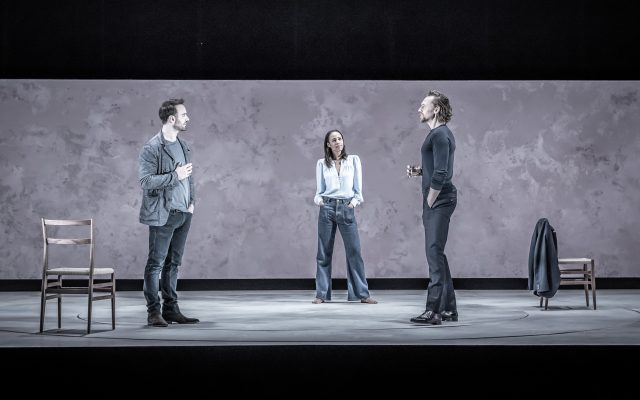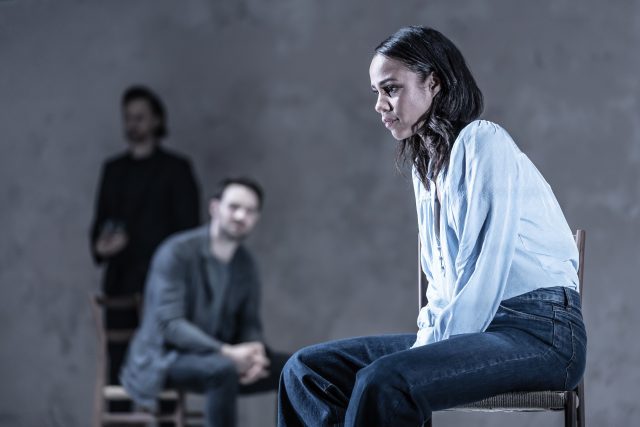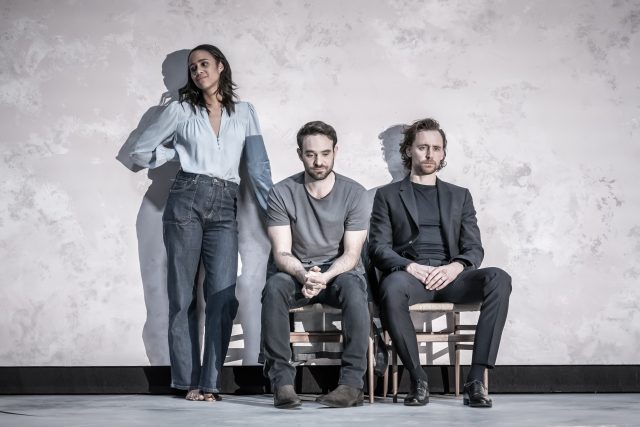
Jerry (Charlie Cox), Emma (Zawe Ashton), and Robert (Tom Hiddleston) are caught up in a circular love triangle in Betrayal (photo by Marc Brenner)
Bernard B. Jacobs Theatre
242 West 45th St. between Broadway & Eighth Ave.
Tuesday – Sunday through December 8, $25 – $189
betrayalonbroadway.com
Jamie Lloyd’s minimalist reimagining of Harold Pinter’s Betrayal, which opened tonight at the Jacobs, is not just a great revival; it’s a wholly new, brilliant work of art that is so fresh and alive that I feel like I’ve never seen the play before, although I have twice. Inspired by Pinter’s real-life affair with Joan Bakewell, Betrayal goes backward in time as it details a circuitous love triangle involving gallery owner Emma (Zawe Ashton), her husband, book publisher Robert (Tom Hiddleston), and his best friend, literary agent Jerry (Charlie Cox). The story begins in 1977, as Jerry and Emma meet two years after their long affair ended, and concludes in 1968, when they first became attracted to each other. It’s like a mystery where you know who the killer and victim are but now have to find out what led to that outcome. Except in Betrayal there are no victims; all three protagonists are complicit in the lies and deceit that are deconstructed over the course of ninety tense minutes. (Perhaps the only victim is Jerry’s unseen wife, Judith.)
The suspense starts at the rise of the curtain, which reveals Soutra Gilmour’s stark set, featuring three chairs and the three characters standing in front of a long, L-shaped marble wall. Jerry and Emma each grab a chair and move to the tip of the stage, where they sit down and share intimate details of their relationship. It’s uncomfortable in an exciting yet unsettling way, getting right in the face of the audience; meanwhile, Robert stands in the back, as if a ghost listening in, the cuckold all alone. Throughout the play, as it travels in reverse chronology, the three characters are onstage nearly the entire time, moving the chairs around as they go from a bar to a restaurant to a furnished room, from England to Italy. In most of the scenes, two of them are speaking while the other hovers cryptically, although all three appear together a few times, amplifying the dynamic among them. They wear the same clothes through most of the play — Gilmour designed the costumes as well — as if they are trapped by time. The set also includes two rotating sections, slowly spinning the characters in circles, mimicking their relationships, especially at one dazzling moment when one circle goes clockwise, the other counterclockwise, leaving the audience awed and nearly dizzy. Jon Clark’s lighting amplifies the suspense, creating eerie shadows as the wall moves up and back.

Emma (Zawe Ashton) considers her predicament in Pinter revival (photo by Marc Brenner)
All three characters lie, emitting falsehoods that are so intertwined with who they are that it’s impossible to take anything they say at face value. Their memories are untrustworthy too; for example, Jerry keeps forgetting whose kitchen he was in when he threw Charlotte, Emma and Robert’s daughter, up in the air, a seemingly insignificant fact that he just can’t get right, if we are to believe Emma. Lloyd (Assassins, Pinter’s The Caretaker) makes the most of Pinter’s trademark pauses and silences, incorporating specialized movement and incidental sound and music by Ben and Max Ringham; he even slyly includes a snippet of Susan Boyle’s haunting version of Depeche Mode’s “Enjoy the Silence.”
The three leads are phenomenal in a play that has always been a big-name vehicle. Raul Julia, Blythe Danner, and Roy Scheider teamed up in the Broadway debut in 1980, Liev Schreiber, Juliette Binoche, and John Slattery joined together for the 2000 revival, and Daniel Craig, Rachel Weisz, and Rafe Spall starred in Mike Nichols’s 2013 iteration; the 1983 film boasted Jeremy Irons, Patricia Hodge, and Ben Kingsley. The tall, lithe, classically trained Hiddleston (The Avengers, Othello) is elegant and graceful as Robert, a potent counterpart to Cox’s (Daredevil, Incognito) more earthy and straightforward Jerry; their longtime bromance adds an extra dimension to their individual relationships with Emma, who is stunningly portrayed by novelist, playwright, film director, and actress Ashton (Velvet Buzzsaw, Gone Too Far!); it is easy to see why both men fall in love with her. Emma is smart, beautiful, and ambitious, enticingly barefoot throughout, a woman who knows what she wants and is not afraid to go after it, but she doesn’t necessarily fully contemplate the potential consequences of her decisions. Eddie Arnold is humorous as the waiter in an Italian restaurant, but this Betrayal is not a dark tale in need of comic relief. I had never thought of it as a comedy, but it is surprisingly laugh-out-loud funny, particularly in Hiddleston’s often satirical delivery.

Zawe Ashton, Charlie Cox, and Tom Hiddleston excel in Jamie Lloyd revival of Betrayal at the Jacobs (photo by Marc Brenner)
Theater is different from books and movies in that you can see plays multiple times in unique adaptations, each making their own mark on the story, for good or bad. You can read a book or see a film more than once, but it doesn’t change, although you do. With Betrayal, Lloyd has breathed new, vital life into Pinter’s nearly forty-year-old Olivier Award winner. In the opening scene, Emma tells Jerry, “It’s nice, sometimes, to think back. Isn’t it?” He replies, “Absolutely.” It’s also more than nice to think forward. Don’t miss this opportunity to see this profound, organic interpretation that captures the heart and soul of Pinter’s bold original.